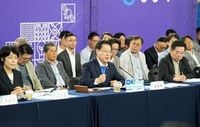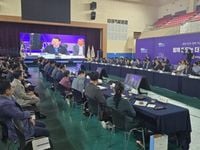On June 24, 2025, Kim Young-rok, Governor of Jeollanam-do, led a pivotal event at the Gwangyang Seunghwang Sports Center, unveiling an ambitious blueprint to transform Gwangyang City into a dynamic new growth hub. The 'Gwangyang City Policy Vision Tour' drew around 150 participants, including prominent figures such as Kim Tae-gyun, Chairman of the Jeollanam-do Provincial Council, Jung In-hwa, Mayor of Gwangyang, and Choi Dae-won, Chairman of Gwangyang City Council, alongside local officials, researchers, and citizens eager to shape the city’s future.
Governor Kim emphasized Gwangyang’s unique position as a city where nature and industry blend seamlessly. Nestled along the 550-ri Seomjingang River, and boasting major industrial infrastructures like POSCO and the Gwangyang Port, the city stands out as Jeollanam-do’s youngest city with a rare three-year streak of population growth. “Gwangyang is the best city in the country where the natural environment and large-scale industries harmonize perfectly,” Kim stated, highlighting the city's leading role in the secondary battery industry and its competitive edge in steel and port sectors.
The event’s centerpiece was the presentation by the Jeonnam Research Institute of seven comprehensive future development strategies under the slogan, "Gwangyang, the heart of K-advanced industries and a new growth hub of the global maritime era." These strategies aim to propel Gwangyang into a future defined by innovation, sustainability, and economic vitality.
First on the agenda is the innovation of the K-Steel industry, with plans to lead the world in eco-friendly steel production. This includes a transition to hydrogen reduction steelmaking and the implementation of a low-carbon circular economy. To strengthen competitiveness, a special law is proposed to facilitate subsidies and create a mega sandbox environment, while transforming the Gwangyang National Industrial Complex into an eco-friendly industrial zone through recycling of by-products and gases.
Complementing this is the vision to establish Gwangyang as a specialized city for secondary batteries. A massive 7.18 million pyeong (approximately 23.7 million square meters) national advanced strategic industry complex is planned to foster domestic supply chains for critical raw materials like lithium and nickel. Furthermore, a future advanced materials national complex will nurture industries producing functional and eco-friendly materials for future mobility. The plan also includes creating a circular economy ecosystem for recycling waste batteries and promoting next-generation battery industries such as energy storage systems (ESS).
The third pillar revolves around the development of Gwangyang Port into a smart port, leveraging Korean-style smart technologies to boost container exports and transshipment volumes. The goal is to reach 3 million TEU by 2030, aiming to place Gwangyang among the world’s top 50 container ports. Key infrastructure projects include dredging container terminal access routes and developing the port’s northern hinterland.
To complement industrial growth, the plan envisions Gwangyang as a transportation hub completing the industrial belt of the Gwangyang Bay area. This will facilitate seamless logistics and connectivity, further enhancing the city’s strategic importance.
Tourism is another vital focus, with aspirations to transform Gwangyang into a K-tourism city attracting 10 million visitors annually. Mayor Jung In-hwa underscored the urgency of expanding foundational tourist infrastructure, particularly at the Gubongsan Observatory, to accommodate the expected surge in visitors driven by development projects linking Baekunsan, Gubongsan, and the Seomjingang region. He requested a budget of 1 billion won to fund parking lot expansions, rotary intersection installations, and safety barrier improvements.
Supporting cultural heritage preservation, requests were made to fund the relocation of the aging Gwangyang Veterans Hall, which currently hampers usage by some organizations due to its dilapidated state. Lee Geun-hwi, Chairman of the Gwangyang City Veterans Association, sought 500 million won for this purpose. Additionally, Lee Byeong-man, Chairman of the Gwangyang City Tourism Association, appealed for 600 million won to build the Jeonsu Education Center, dedicated to the transmission and preservation of the 'Gwangyang Jinwol Jeoneojabi Sori,' a provincial intangible cultural heritage.
Governor Kim acknowledged these cultural and infrastructural needs, stating, “While provincial support for the Veterans Hall is challenging, we will exert every effort to secure national funding by applying next year. For the Jeonsugwan construction, 160 million won has been allocated for demolition and design, and we will work with the National Cultural Heritage Administration to confirm future construction costs.”
Environmental and energy concerns were also voiced during the tour. Heo Hyeong-tae of the Gwangyang Bay Environmental Education Center proposed transferring integrated management authority for environmental pollution facilities to local governments to enhance prevention and responsiveness. Meanwhile, Ahn Seong-soo, Chairman of the Gwangyang City Venture Business Association, called for streamlined licensing procedures and resolution of systemic issues to facilitate citizen-participatory solar power plant projects on idle lands, aiming to share profits with local residents. He also urged support for designating Gwangyang as a specialized complex for secondary battery raw materials and components.
Governor Kim concluded the event by emphasizing Gwangyang’s pivotal role in Jeollanam-do’s strategic industries. “Gwangyang is the core of our province’s strategic industries. We will actively support the expansion of necessary infrastructure and the designation of specialized complexes to ensure the city’s growth and sustainability,” he said.
The Jeollanam-do provincial government affirmed its commitment to thoroughly review the proposals discussed during the policy vision tour, promising to pursue national budget allocations and institutional reforms to realize Gwangyang’s ambitious future vision.
This concerted effort to harmonize natural beauty with cutting-edge industry and cultural heritage paints a promising picture for Gwangyang. As it positions itself at the forefront of steel innovation, secondary battery specialization, and global logistics, the city is poised to become a beacon of sustainable growth and a magnet for tourism and entrepreneurship in South Korea.


